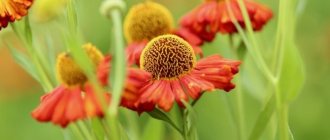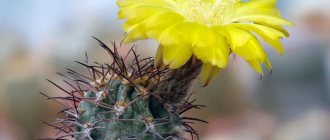Author: Elena N. https://floristics.info/ru/index.php?option=com_contact&view=contact&id=19 Category: Garden plants Published: February 24, 2019Last edits: January 20, 2021
- When to plant
- Growing conditions
- Duplex
plant (lat. Lathyrus odoratus) belongs to the Chin genus of the Legume family. The scientific name of the plant consists of two words, the first of which is translated as “very attractive”, and the second as “fragrant”. Some botanists claim that this flowering herbaceous plant is native to the Eastern Mediterranean - its range extends from Sicily east to the island of Crete. Other scientists believe that sweet peas were brought to Sicily by conquistadors from Ecuador and Peru. The plant has been cultivated since the 18th century: in 1699, while walking under the walls of the monastery, the Sicilian monk Francisco Cupani discovered a flower with an unusually pleasant smell, collected seeds from it and sent them to England to his friend, a school teacher. And in England, thanks to the work of breeders, sweet peas over time became the king of ampels. The first five varieties of the plant appeared in 1800. Today there are more than 1,000 varieties of sweet peas. Gardeners are attracted by the bright flowers and pleasant smell, which is where the plant got its name. Sweet peas are most often used for vertical gardening of gazebos, balconies and terraces. Perennial sweet peas in the middle zone are usually grown as an annual crop
Planting and caring for sweet peas
- Flowering: from July until frost.
- Planting: sowing seeds for seedlings - in mid-March, planting seedlings in the ground - at the end of May.
- Lighting: bright light.
- Soil: moist, well-drained, fertilized, with a pH of 7.0-7.5.
- Watering: regular, on average once a week, using 30-35 liters of water per m².
- Feeding: not necessary, but will not interfere: at the beginning of growth - with a solution of 1 tablespoon of Nitrophoska and 1 tablespoon of urea in 10 liters of water, at the beginning of flowering - with a solution of 1 tablespoon of Agricola and 1 tablespoon of potassium sulfate in 10 liters of water, at the height of flowering - a solution of 1 tablespoon of Agricola for flowering plants and 1 tablespoon of Rossa in 10 liters of water.
- Garter: tall varieties of peas need to be tied to a support.
- Hilling: carried out regularly to a height of 5-7 cm with fertile soil added to the base of the stem - this stimulates the development of adventitious roots in the plant.
- Reproduction: seed.
- Pests: root weevil and various types of aphids.
- Diseases: ascochyta blight, powdery mildew, downy mildew, fusarium blight, root rot, blackleg, viral mosaic and deforming viral mosaic of peas.
Read more about growing sweet peas below.
Caring for seedlings at home
After sowing, the plant needs careful care. And therefore, compliance with all measures and rules provides a favorable environment for growth. Sprouts appear a few weeks after planting. Nodules begin to form with a slight temperature difference, so the seedlings are transferred to a cooler room and the cover is removed. The temperature should be from +15 to +17 degrees.
Some tips:
- It is advisable to place the seedlings on the south side so that the plant does not feel the lack of light. If there is not enough natural light, then you need to use artificial lighting for 2-3 hours every day.
- The soil should be constantly moist, so it is advisable to water it every week. To prevent drying out, you can cover the seedlings.
- Monitor the amount of water, because if you water too often, the roots may rot.
As for picking, the answer is simple. Not recommended!
Due to the fact that it is very sensitive, picking should be out of the question. Any manipulations carried out with its roots can lead to injury, so it is better not to touch the root system.
But feeding won't hurt. In this case, mineral fertilizers are perfect. Kemira solution has a beneficial effect on growth.
When the first three leaves appear, pinch the top to increase the shoots.
With proper and timely care and compliance with all rules, you can easily achieve favorable results. And after that, feel free to move on to the next part: planting in open ground.
When the first three leaves appear, pinch the top to increase shoots
Botanical description
The sweet pea flower, or sweet pea, was described by Carl Linnaeus in 1753. The root system of the plant is highly branched, taprooted, penetrating into the soil to a depth of one and a half meters. Like most legumes, sweet peas enter into symbiosis with nodule bacteria that absorb nitrogen from the air. The stems of the tree are climbing, weakly branched, they climb up the support, clinging to it with modified leaves - branched tendrils. Sweet pea flowers resemble moths, but the British think they are like a boat under a sail: the corolla consists of a large petal, similar to a wide oval sail, two side petals (“oars”) and two fused lower petals, forming a “boat.” Sweet peas bloom profusely. It begins in July and with proper care continues until frost. The fruits of sweet peas are small bivalve beans with 5-8 spherical, laterally compressed seeds of yellow, greenish or black-brown color, which remain viable for 6 to 8 years.
Rules of care
With good and proper care, the plant will bloom until late autumn.
- Timely and regular watering. Monitor the condition of the soil, do not allow it to dry out, but also do not flood it, so that there is no stagnation of water.
- Loosening the soil and removing weeds. When loosening, do not allow the roots to become exposed; this will lead to withering of the plant.
- To stimulate the growth of adventitious roots, it is necessary to hill the plant to a height of 5-7 cm.
- Twice a month, fertilize the soil with organic fertilizers.
- Do not let the seeds ripen; cut off the dried flowers. This will extend the flowering period.
- Sweet peas do not require pruning.
Growing sweet peas from seeds
How to sow seeds
Cultivation of sweet peas begins with sowing seedlings in mid-March. Before sowing, slow-germinating sweet pea seeds should be soaked in water for 10-12 hours or kept in a fifty-degree solution of the drug Bud (1-2 g per 1 liter of water). Then, for 2-4 days, they are germinated in gauze, wet sand or sawdust at a temperature of 20-24 ºC. As soon as the sweet pea seeds sprout, they should be sown immediately.
Store-bought soils Saintpaulia, Rose or a mixture of humus, peat and turf soil in a ratio of 2:2:2:1 are best suited as a substrate. Any of these substrates must be disinfected with a strong solution of potassium permanganate, and it is better to use cups or pots as containers for growing seedlings. Sowing is carried out in a moist substrate to a depth of no more than 2-3 cm, placing 2-3 seeds in each cup. If you sow peas in a common box, then the distance between the seeds should be about 8 cm. After sowing, the substrate is watered, the containers are covered with film and kept on a sunny windowsill at a temperature of 18-22 ºC.
- Ampelous plants: planting and care
Seedling care
When massive seed germination begins, and this can happen in a week or two, you need to remove the film from the crops and lower the temperature to 15-16 ºC - this measure promotes the formation of nitrogen-fixing nodules on the roots of the seedlings. Keep the substrate slightly moist at all times and provide the seedlings with good lighting: if you do not have the opportunity to keep the seedlings in a south-facing window, provide them with artificial lighting for 2-3 hours daily. To do this, you can use a phytolamp or a fluorescent lamp, fixing them at a height of 25 cm above the seedlings and turning them on, for example, from 7 to 10 or from 17 to 20.
In the development phase of 2-3 true leaves, seedlings are pinched to stimulate the development of side shoots. After pinching, the seedlings are fed with a solution of 2 g of Kemira in 1 liter of water.
How and when to plant sweet pea seedlings
It is permissible to plant the plant in both summer and winter. Planting dates are determined taking into account the region and method of planting. Before direct planting, the soil must be treated with solutions against parasites. It is recommended to sow seeds a month before planting in the ground.
You should prepare the necessary equipment, wait for a favorable time and follow the sequence of the landing algorithm.
Sowing is done at the end of March or beginning of April. The flowering period occurs in July and continues until the onset of frost.
Preparing containers and soil
First you need to select a container. Since they have a long root, plastic or peat cups with a volume of 200-250 ml are suitable. There must be drainage holes at the bottom of the container. If you don't have them, you need to do them.
To plant seeds, use universal soil or prepare the soil yourself. How to choose and prepare soil for seedlings
It should be well moistened, fertilized and drained.
In order to germinate seeds, you need:
- Place the material in a cotton cloth.
- Wrap it in cloth and put it in a plastic bag for several days. Store the package in a warm room at a temperature of 20-25 degrees.
- For better effect and faster germination of seeds, they can be soaked in solutions.
- You should check every day whether they have sprouted. And also make sure that the material does not dry out.
To increase the growth rate, you can use both organic solutions and various preparations. Organic fertilizers include aloe juice. Among the preparations you can use Zircon.
Plant growth stimulator
Sowing
Direct sowing of seedlings is carried out after careful preparation of everything necessary. To do this you need:
- Place drainage at the bottom of the container (if plastic glasses are used).
- After this, cover with soil so that 2 cm remains from the edge of the cup.
- Soak the soil well with warm water.
- Make small holes and place the seed there.
- Fill the top with a small amount of soil and water again.
- Cover the glass with a plastic bag to create a greenhouse effect.
Sweet pea shoots
Planting sweet peas in the ground
When to plant
Sweet peas from seeds are planted in open ground towards the end of May, when the soil has warmed up and the threat of return frosts has passed. If by that time the seedlings have already formed buds or flowers, tear them off so that all the energy of the plants can be directed to the formation of the root system. 10 days before planting seedlings, it is necessary to carry out hardening procedures with it. To do this, containers with seedlings are taken out into the open air every day, gradually increasing the duration of stay until the sweet pea seedlings can stay outside for a whole day.
How to plant
Sweet peas love light, warm areas and moist, well-drained soil enriched with fertilizers with an acidity pH of 7.0-7.5. Before planting seedlings, dig up the area to the depth of a spade with compost or humus, phosphorus and potassium fertilizers. Do not use fresh manure as fertilizer, as it provokes fusarium wilt, and do not apply nitrogen fertilizers: sweet peas do not need them.
Make holes in the row at a distance of 20-25 cm from each other and plant 2-3 plants in each. For tall varieties of sweet peas, you need to immediately install supports. Keep in mind that annual sweet peas must be disposed of in the fall, and the plant can only be replanted in this area after 4-5 years.
Variety selection
For balconies and loggias, annual plants are chosen, the flowers of which, unlike perennials, have a variety of colors and a strong, delicate aroma. Groups of varieties are combined according to the growing season, the height of the main stem, the number of flowers in the cluster, and flowering time.
- Tall varieties include Spencer, Mammut, Royal Family, and Cuzbertson-Floribunda. Varieties of these groups can reach 2-2.5 meters in height .
- Moderate height from 60 cm to 1.5 meters is characteristic of the varieties “Multiflora Gigantea”, “Kni-Khi”, “Jet”.
- Miniature loaches from the “Bijou” and “Little Sweetheart” groups do not exceed a height of 40 cm and grow well in balcony boxes and flowerpots.
Cultivated varieties of sweet peas are distinguished by large, beautiful flowers, various shades and duration of flowering.
Caring for sweet peas
Growing conditions
Planting and caring for sweet peas is not labor intensive. How to grow sweet peas? It needs watering, weeding, loosening the soil, supports, fertilizing and protection from diseases and pests. Watering must be regular and sufficient, since due to lack of moisture, buds and flowers may fall from the plant, and the duration of flowering may be greatly reduced. If the summer is rainless, sweet peas need to be watered weekly, using 30-35 liters of water per m² of planting. You can prolong flowering by promptly removing faded flowers.
Tall varieties of sweet peas need to be tied to supports, which are used as twine or mesh. As the peas grow, their stems are directed in the desired direction and tied up.
In order to stimulate the development of adventitious roots, it is necessary to hill the plants to a height of 5-7 cm and add fertile substrate to the base of the stem.
As for fertilizing, they are not required, but desirable. At the beginning of growth, sweet peas are fertilized with a solution of 1 tablespoon of Nitrophoska and 1 tablespoon of urea in 10 liters of water. At the beginning of flowering, a solution of a tablespoon of Agricola and the same amount of potassium sulfate in 10 liters of water is used for feeding, and at the height of flowering, sweet peas are fertilized with Agricola for flowering plants and Rossa, dissolving one tablespoon of fertilizer in a bucket of water.
Sweet peas do not need pruning.
Pests and diseases
Among the pests that pose a danger to sweet peas are the nodule weevil and various types of aphids. At the beginning of the growing season, the weevil gnaws out semicircles along the edges of the leaves, and its larvae eat the roots of the plant. As a preventive measure against the pest, when planting seedlings, pour 100 ml of a 0.1% Chlorophos solution into each hole. The plants themselves need to be sprayed with the same solution.
Of all the types of aphids that can attack sweet peas, bean aphids, chin aphids and pea aphids. These tiny pests suck the juices out of plants, deforming their organs, and infect them with viral diseases. In order to destroy aphids, as well as for prevention, sweet peas are treated 2-3 times during the growing season with Zineb or Ciram with a break between sessions of 2-3 weeks.
Among the diseases, sweet peas can be affected by ascochyta blight, powdery mildew, downy mildew, fusarium blight, root rot, black leg, viral mosaic and deforming viral mosaic of peas.
- Replanting juniper - how to prepare mycorrhiza yourself
With ascochyta blight, brown spots with clear boundaries appear on the leaves, beans and stems of peas. You can fight the infection with two or three treatments with a solution of Rogor at an interval of 2-3 weeks.
Powdery mildew and downy mildew (downy mildew) appear in the second half of summer as a loose whitish coating on the leaves and stems of plants. Over time, the leaves turn yellow, turn brown and fall off. Destroy pathogens with a five percent solution of colloidal sulfur by washing the leaves with it.
Signs of fusarium are yellowing and wilting pea leaves. Diseased plants cannot be treated; they must be removed, while healthy ones must be treated with a solution of the drug TMDT. As a preventive measure, crop rotation should be observed on the site.
Black leg and root rot cause the root collar and roots of sweet peas to darken, and the plant dies. Infected specimens cannot be saved; they must be removed, and healthy ones must be transplanted to another place, having first disinfected the soil and roots of the plants.
The viral mosaic appears as a line pattern on the leaves, and the tops of diseased shoots become twisted and deformed. Plants infected with any of the viral diseases must be removed and burned, since they cannot be cured.
Landing Features
To grow on your plot , planting and caring for them will not be difficult. There are two ways to plant it: sow the seeds in open ground or use seedlings. To create the most favorable environment for the growth of sweet peas, when choosing a variety, you should pay attention to the conditions for its cultivation.
Growing from seeds
In order for sweet peas to bloom in June, the seeds must be sown in April-May . If you want to grow a large and lush plant, you need to properly prepare the beans for planting. Since beans have a hard shell, they take a long time to germinate.
To speed up this process, an incision is made - additional mechanical damage to the shell. Lightly cut the surface with a knife or, using a sewing needle, make punctures in several places.
- To check the completeness of the seeds, they must be placed in a saline solution (30 g of salt per 1 liter of water). Soak different varieties of seeds in hot water for 60 minutes. Floated beans are unsuitable for planting.
- Only brown and gray-brown beans can be soaked. If you have cream-colored or light-colored seeds, they may not tolerate such heat treatment. They are planted dry without soaking.
- After a day, drain the water and create a moist environment for germination; you can add wet sand or sawdust and cover the seeds with a wet cloth, periodically adding water. After about 6-10 days, subject to a temperature regime of 18-23 degrees, the seeds will germinate. After this, they are planted in open ground or a greenhouse.
- First clear the soil of roots and weeds, loosen it well and level it. Prepare holes 2-3 cm deep. The flower will grow well and turn into a lush bush, so the distance between the holes should be 20-25 cm.
- Place 2-5 grains in one hole, making an additional hole for each.
The plant will sprout quickly, when 2-3 leaves are formed, the tops of the shoots must be pinched. In order for the peas to begin to bush, the same must be done with the side shoots.
Seedling method
The process of growing peas using seedlings is more labor-intensive . The difficulty is that the plant has long branched roots, which is why it does not tolerate transplantation well. Therefore, it is better to plant seeds in peat pots or plastic cups.
Then, during transplantation, the root system will not be damaged.
Seeds for seedlings are planted in the third decade of March or early April. If you plant later, the roots will not have time to form and the plant will wither.
- Preliminary preparation of beans is carried out similarly to the method of growing from seeds, they are soaked and germinated.
- It is better to grow seedlings in a greenhouse, since at home, due to lack of lighting, the plant will become very elongated and may break during transplantation. Alternatively, provide additional lighting.
- Prepare containers (pots or glasses) and fill them with a soil mixture of turf soil with the addition of sand and peat. For 2 kg of soil - 1 kg of peat and half a kilogram of sand. You can buy ready-made soil for climbing plants at a specialty store.
- Place 2-3 seeds in each container with pre-moistened soil. Planting depth is 2-3 cm. Water and cover with film on top to create a greenhouse effect and retain moisture in the ground.
- Seedlings must be watered regularly and provided with plenty of light and heat.
- After one or two weeks, the peas will begin to sprout. When the first three leaves grow, you need to pinch the top. This is done so that the side shoots begin to grow more actively.
- After this, watering is reduced to once a week.
- After 40 days, approximately in mid-May, when the height of the seedlings reaches 5-10 cm, the seedlings can be planted in open ground.
- Prepare holes at a distance of 20-25 cm. Transplant 2-3 plants into each hole, carefully pulling them out of a plastic cup along with the soil. Or plant it together with a peat pot.
- For tall varieties, immediately prepare supports, you can take a net or twine, and start tying small stems, not forgetting to set the right direction.
Types and varieties
There are more than 1000 varieties of sweet peas. They are all divided into 10 garden groups, of which the following are most often grown:
Duplex
Plants with strong stems and flowers with a double sail, collected in inflorescences of 4-5 pieces. One of the best varieties of the group:
- Cream - a plant up to 90 cm high with fragrant flowers up to 4.5 cm in diameter, light cream in color with a folded or double sail. The inflorescences, located on straight peduncles up to 20 cm high, consist of 3-4 flowers;
Galaxy
Created in 1959, a group of late-flowering varieties more than 2 m high with strong inflorescences 30 to 50 cm long with 5-8 corrugated, often double flowers up to 5 cm in diameter. These plants are recommended for landscaping and for cutting. The best varieties:
- Neptune is a branched variety up to one and a half meters high with strong straight peduncles up to 30 cm high, on which blue flowers up to 5 cm in diameter are collected in inflorescences of 5-7 pieces with a white base and often with a double sail;
- Milky Way is a branched sweet pea up to 145 cm high with very fragrant soft cream flowers up to 5 cm in diameter with a double sail, of which there can be 5-6 pieces in one inflorescence;
Bijou
Created by the Americans in 1963, a group of semi-dwarf late varieties up to 45 cm high with strong inflorescences up to 30 cm long, consisting of 4-5 corrugated flowers with a diameter of up to 4 cm. These plants can be grown without supports, they are recommended for borders and ridges;
Spencer Group
which includes powerful multi-stemmed plants up to 2 m high with racemose inflorescences consisting of 3-4 simple or double corrugated flowers up to 5 cm in diameter with wavy petals. The group is represented by varieties with a medium flowering period and is recommended for landscaping and cutting. The best varieties of the group:
- Warrier is a plant with dark purple flowers with white strokes at the base of the boat, located on straight peduncles. The diameter of the flowers is about 4 cm, the sail is wavy, and the oars are bent;
- Jumbo is a variety up to 100 cm high with salmon-pink flowers, a white boat, a slightly wavy sail and slightly bent oars. The aroma of flowers with a diameter of about 4 cm is weak, the peduncles are straight and strong;
- Charlotte - the stems of this variety are up to 150 cm high, the flowers are bright crimson, up to 4.5 cm in diameter, the sail is wavy, the paddles are widely spaced. Inflorescences of 2-4 fragrant flowers are located on strong peduncles up to 25 cm high;
- Cream Gigantic is a plant up to 175 cm high with large creamy, fragrant flowers up to 4.5 cm in diameter, a wavy sail and widely spaced, slightly bent paddles. Inflorescences, consisting of 3-4 flowers, are located on peduncles up to 30 cm high.
In addition to those described, varieties of the group Spencer Monty, Mahogany, Flagship, King Lavender, Ayer Worden, Garnet and others are popular;
Earley Spencer
Created by the Americans in 1910, a group of early varieties 120-150 cm high with inflorescences up to 35 cm long, consisting of 3-4 corrugated flowers with a diameter of up to 4.5 cm. The varieties are recommended for landscaping and for cutting;
Cupido
Created back in 1895, a group of low-growing varieties up to 30 cm high with inflorescences up to 7 cm long, consisting of 2-3 medium-sized flowers of various colors. These varieties are recommended for landscaping;
Cuthbertson-Floribunda
A group of varieties created in 1952 in America. These are tall plants up to 2 m high with strong inflorescences up to 40 cm long, consisting of 5-6 large corrugated flowers with a diameter of up to 5 cm. These early ripening varieties are recommended for cutting. The best of them include:
- How to grow annual phlox from seeds: sowing and picking
- David is a variety up to 140 cm high with large fragrant dark crimson flowers with a white stroke at the base of the boat and a wavy sail. Inflorescences consisting of 5-6 flowers up to 5 cm in diameter are crowned with hard peduncles up to 30 cm long;
- Kennet is a variety up to 1 m high with large dark red flowers, collected in inflorescences of 5-6 pieces. The diameter of the flowers is about 4 cm, their sail is slightly corrugated, the oars are slightly bent, the peduncles are up to 16 cm long;
- White pearl is a white sweet pea with flowers about 4.5 cm in diameter, collected in inflorescences of 5-6 pieces and located on peduncles up to 30 cm long.
In addition to those described, such varieties of the group as Zhelanny, Peggy, Robert Blain, William and others are also widely known;
Royal Family
This group of heat-resistant varieties was created in 1964. They are an improved version of the Cuthbertson-Floribunda group varieties. Inflorescences up to 30 cm long consist of large double flowers of various colors depending on the variety. The disadvantage of these plants is their increased sensitivity to daylight hours, so they are not grown in winter. Varieties of this group are recommended for landscaping and for cutting;
Multiflora Gigantea
This group of early varieties up to 2.5 m high was created in 1960 by American breeders. The plants have strong inflorescences from 35 to 50 cm long, consisting of 5-12 corrugated flowers with a diameter of about 5 cm. The varieties are recommended for landscaping and for cutting;
Rufled
A group of powerful plants with 6-10 large flowers in one inflorescence. The peduncles are long and strong, the sail is wavy. The best varieties of the group:
- Grace is a branched plant up to 155 cm high with inflorescences consisting of 5-7 fragrant pale lilac flowers about 5 cm in diameter with dark veins and a wavy sail. The height of rigid peduncles is up to 35 cm;
- Ramona is a variety up to 130 cm high with bright carmine flowers with a white tongue at the base of the boat and a wavy sail. In one inflorescence, located on a rigid peduncle up to 30 cm long, there are 5-6 flowers with a diameter of up to 5 cm;
Intergen
A group of early low-growing varieties bred in 1991 by Russian breeders, filling the niche between the varieties of the Cupido and Bijou groups. The height of plants in this group is from 35 to 65 cm, so they can be grown without supports. Inflorescences up to 20 cm long consist of 3-4 simple flowers with a diameter of up to 3 cm. The best variety:
- Geniana is a plant with a height of 30 to 50 cm with very fragrant white and lilac flowers;
Lel
A group of varieties, bred in the same year, intermediate between Bijou and Multiflora Gigantea, with a height of 65 to 100 cm with strong inflorescences up to 30 cm long, each of which consists of 7-12 corrugated flowers with a diameter of up to 4.5 cm. Popular varieties of the group:
- Lucien is a very fragrant plant 40-60 cm high with light pink flowers;
- Lisette is a very sweet pea, 40 to 60 cm tall with bright red flowers.
In the 70s of the 20th century, groups of English varieties Jet Set and German Laisers Koeningspiel were created. Currently, breeding work on sweet peas continues.
Sweet pea: appearance and history of appearance
Lathyrus Odoratus belongs to the genus of the large legume family. This is a herbaceous climbing plant with small, but graceful and abundant flowers, collected in a brush, which many gardeners compare in shape to a smaller copy of an orchid. The color of the flowers can be varied: from soft blue to rich blue and purple and from white and soft pink to red and burgundy.
Sweet peas can decorate any area
For your information! Currently, two-color varieties have also been developed, which are becoming increasingly popular.
Peas are a perennial, although in certain climatic conditions this fragrant flower is grown as an annual. In addition, thanks to the painstaking work of breeders, many annual varieties have appeared, which are represented by a more diverse range of colors.
Fragrant peas begin to bloom in late June - early July, but the duration of its flowering depends on how it is cared for. If you follow some simple rules, the plant will delight you with numerous flowers until frost.
Currently, two-color pea varieties have been developed
The stems of peas (peas) are ribbed, the leaves are complex, pinnate, and bright green. At the ends of the leaves there are tendrils, thanks to which the plant can curl, clinging to support. The height of this aromatic plant depends on what variety it is, and can vary from 15-20 cm to 2-2.5 m. The fruits of the tree are pubescent, not very long beans with several seeds.
It is believed that the birthplace of sweet peas is Sicily. It was from there that it was brought first to India, and then to Europe. Today, decorative peas as a garden plant are especially revered in England, where even entire communities of its lovers have been created. The perennial sweet pea has become a unique symbol of garden design here.
Important! Sweet pea seeds are poisonous, so it is best to keep them away from children and animals.
Timing of sowing seeds
Before planting this plant, you need to carefully familiarize yourself with the conditions that will be optimal for its growth. If you decide, then there is no need to delay planting the plant, since its growing season is generally only three months. The sooner you plant an annual, the sooner it will delight you with its flowering.
For each climate zone, planting of this plant occurs at different times. If it is recommended to plant sweet peas in the spring in your climate zone, then the soil must be heated to a sufficient depth. Otherwise, the seeds will simply freeze. You can prepare for this process in advance and grow seedlings.
Important! Plant only in warm soil. If the winter is very harsh and protracted, then it is recommended to plant sweet peas in a greenhouse or any other enclosed space.
City dwellers manage to do this in an apartment or on a balcony. The main condition is compliance with the temperature regime, which will be favorable for the flower.
If the climate is moderate, they begin to think about planting at the end of April, beginning of May. We are talking about planting seeds in open ground. The soil has warmed up, which means the seeds should not freeze. Thanks to warmth and precipitation, seeds germinate quickly. Soon the tree begins to bloom.
Soil, fertilizing
Sweet peas grow well in fertile soil that is not supplemented with fresh organic fertilizers. In order for the plant to feel great on the balcony, it needs to be planted in deeper containers. And everything is done to ensure that the growing root system develops correctly.
Poorly fertilized soil negatively affects the flowering of annuals. If the soil is fertilized above the norm, then an increase in green mass occurs. Flowering occurs later than always, the number of flowers is small. There are practically no seeds.
The plant needs to be fed and watered regularly. As a top dressing, it is recommended to use mineral fertilizers that have a low nitrogen content.
Seedlings planted on the ground receive their first feeding after a week. To do this, you will need a bucket of water with urea and nitrophoska dissolved in it. One tablespoon of urea and nitrophoska per bucket of water is enough. The flower will need a second feeding when it begins to bloom. The third feeding is during the period of vigorous flowering.
Know! Thanks to feeding, the annual will delight you with its blooms all summer long.
Most leguminous plants have a beneficial effect on soil fertility. These include the fragrant china. In the process of decomposition of the remains of the root system, the soil is enriched with nitrogen. Thus, the plant is able to provide itself with nitrogen. It is not recommended to plant sweet peas in one place for more than two years in a row. Experts say that it will not bloom beautifully.
China fragrant and traditional medicine
The healing properties of the annual plant have not been fully studied. Traditional medicine has been using it for a long time. It strengthens the immune system, helps with colds and vitamin deficiency. For insomnia, diseases of the cardiovascular system and gastrointestinal tract, a decoction of pea tubers is prepared. Tincture of the plant treats respiratory tract disease. It has a good expectorant effect.
Conclusion
Sweet peas are an easy to care for and beautiful plant. It is very popular among experienced gardeners. An annual flower, not capricious. Anyone can grow it, despite the number of recommendations. The beauty and tenderness of flowers, a pleasant aroma will lift your spirits and relieve any pain. You will definitely like the sweet pea plant!
Pests and diseases of China
Aphids and root weevils are considered dangerous pests for the plant. For preventive purposes or for pest control, special preparations are used:
- Chlorophos (0.1% solution) from weevil;
- Tsineb, Tsiram from different types of bean aphids.
These preparations are sprayed on the plant several times a season. With a break of about a month between procedures.
Among the common diseases of sweet peas, the most common are root rot, viral mosaic, and ascochyta blight. Prevention of these ailments involves treating peas with Rogor solution. In the event of the spread of diseases, infected specimens must be removed from the garden bed, otherwise the disease will affect the entire planting. Before planting the plant in a new location, it is advisable to disinfect the soil with a solution of manganese or fungicides.
Description of the plant, photo
The plant has thin ribbed stems, a pair of leaves, and tendrils at their ends. Thanks to its antennae, it clings to a support and grows upward, towards the sun. Initially, you need to monitor, guide, and also tie up in time. Dwarf species of sweet pea are also known. Their height reaches 40 cm. Such plants can decorate any window or balcony of a city dweller. They can be planted along the edges of flower beds in suburban areas.
The flower of the plant is very beautiful; it has a very delicate inflorescence, thanks to which an ordinary garden plot becomes like a real piece of paradise. The flowers are collected in large clusters, the peduncles are long and leafless.
The flower has a corolla and five brightly colored moth-like petals. The upper petal of the flower is the largest, its diameter is up to 6 cm. It is called “sail”. The two lower petals resemble a “boat”, and the “oars” form the two middle petals. The flower remains beautiful and fresh for up to 5 days.
The fruit of a plant of the legume family, naturally, is a bean. Only a few round seeds ripen inside the fruit. When properly storing seeds, observing the permissible humidity and temperature conditions, their germination will last up to 8 years.
Seeds are not always formed after flowering. The reason for this is the sharp change in temperature, both at night and during the day. Despite the fact that the china is not afraid of cold weather, the buds react strongly to changes in day and night temperatures. The buds and flowers fall off, the ovary does not occur. In addition to a sudden change in temperature, the cause may be improper care of the flower.
There are many varieties of this plant known. They differ not only in the shape, size and color of the flower. You can choose the shade of the petals to your liking, thanks to the wide color palette. The plant is climbing, capable of entwining and thereby decorating any support with a real weightless carpet.
A delicate, refreshing aroma comes from the inflorescences of the plant. It fills the air not only in your suburban area, but also in nearby areas. In addition to the tall plant, there are dwarf varieties of sweet peas. The color of the flowers in each variety is different.











